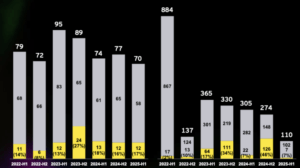The 9 biggest ClimateTech trends for 2024

Last year, some intense weather events were observed around the world, which are likely to continue also in 2024. Just a few days ago, on New Year’s Day, Japan was hit by an earthquake and a subsequent three-meter-high tsunami wave, while England was plagued by floods. “Flooding and icy temperatures continue to cause havoc across Europe” are the headlines in European media such as euronews.
The impacts of climate change are an important reason to keep an eye on the prevailing climate tech trends. Some of them might play a significant role this year in tackling environmental and climate problems. Others may not be relevant in 2024 at all but open new doors for innovation in the future.
Trending Topics has looked at the nine most important ClimateTech trends for 2024:
1. Increasing investment in carbon removal
The task of “Carbon Capture, Utilization and Storage (CCUS)” is to capture, use and store carbon dioxide (CO2). Direct Air Capture (DAC), direct capture from the air, is currently the best way to remove CO2 from the atmosphere. On the one hand, because the air is not tied to a direct source of emissions, on the other hand, filtering machines can be stationed individually. There is currently significant funding available for mainstream implementation, including government grants, venture capital, corporate funds, and startup programs. The International Energy Agency (IEA) predicts that DAC technologies will remove 90 million tons of CO2 per year in 2030 and 980 million tons of CO2 by 2050. “Carbon capturing” is (still) banned in some countries.
2. Next round for battery development
The Swedish battery cell manufacturer “Northvolt” is conducting research with sodium ions for the production of solid-state batteries. They do not contain cobalt, nickel, and lithium and could therefore play an important role in the energy transition. A sodium-ion battery can be made from the widely available minerals iron and sodium. The cell developed is safer, cheaper, and more sustainable than batteries. At the same time, it has a lower energy density than lithium batteries typically used for electric cars. It is therefore only suitable to a limited extent as a car battery. Nevertheless, China plans to equip some BYD and Chery cars with sodium-ion cells, thereby relying on resource-saving battery technology.
3. Mini nuclear power plants remain controversial
Small modular reactors are intended to produce cheap nuclear energy. Their simple construction and size meant they could be mass-produced and several could be placed in one place. Due to the low production costs, it is hoped that energy can be produced cheaply. While the first mini-nuclear power plant, which was supposed to be built in Idaho (USA), was scrapped, SMRs are still being used in Europe. The Czech Republic will probably build the first 300 megawatt mini-nuclear reactor in the Temelín nuclear park. The US company GE Hitachi Nuclear Energy will provide the necessary technology . There is strong criticism of the project from the Austrian government.
4. Balcony power plants to support electricity needs
Interest in balcony power plants is growing – at least in Europe. They usually consist of one or two modules that deliver a maximum of 800 watts of power. By plugging it into a socket, the electricity is passed on to the household. The small photovoltaic systems can be mounted on the balcony and from there generate clean electricity for the apartment.
The resulting advantages are more predictable electricity prices and a high level of environmental friendliness, as energy is generated through solar radiation. In addition, balcony power plant owners no longer need to be afraid of blackouts. For all Austrians who are thinking about purchasing something, now is the right time. Since 2024, PV systems with a peak output of 35 kilowatts have been exempt from sales tax.
5. Generative AI tools for renewable energy
The focus will be on switching to renewable energies in order to finally turn our backs on fossil fuels. Electricity generation from sun, water and wind and its storage will continue to improve worldwide in terms of efficiency and accessibility. One wave of innovation in the field of renewable energies concerns hardware; the second wave will deal with software to optimize energy production and consumption.
A current report from Deloitte describes the possibilities of generative AI projects in the field of renewable energies. For example, generative AI can help select the best locations for renewable energy facilities by taking into account wind patterns, solar radiation and environmental impacts. It can also suggest the best arrangement of solar panels. Project developers will use generative AI tools worldwide: for decisions, processes and for involving the population.
6. Increasing interest in premium carbon credits
Emission credits or carbon certificates work like permits for emissions. If a company buys carbon credits, it may continue to generate CO2 emissions or resell excess credits. Experts see the trend of premium carbon credits: the more expensive the emissions credit, the higher the quality and the greater the positive impact on the environment. By 2024, nature-based carbon credits are expected to account for more than 50 percent of the demand for emissions credits in the financial services sector.
The aim is to simplify the structure of the carbon market so that buyers can securely purchase and redeem credits. According to announcements at COP28, concrete plans for this will be presented in 2024. If successful, the integration of voluntary and regulated measures for issuing emissions credits could stabilize demand and strengthen the confidence of project developers and investors.
7. Perovskite solar technology with increased effectiveness
Solar cells that combine traditional silicon with cutting-edge perovskite tandem solar cells can utilize more of the solar spectrum and generate more power per cell. Perovskites absorb different wavelengths of light compared to silicon cells, which currently make up 95% of the solar market. Specifically, the conventional silicon is overlaid on these cells with materials that have a unique crystal structure. This could result in enormous efficiency gains. If the technology is used on a large scale, perovskite tandem cells would generate more electricity than traditional solar cells at a lower cost.
Research is working hard on perovskite solar technology – the first production attempts are being made, for example, by the German Fraunhofer Institute for Solar Energy Systems. Bill Gates also relies on solar technology and has invested in the American company CubicPV.
8. New drilling techniques for clean energy
Geothermal systems will improve. Geothermal energy is clean, always available and practically limitless. But getting to them is often difficult due to various technical challenges and the special geological conditions that are required. New drilling techniques that go deeper and can be used in places where this was not previously possible will enable more geothermal energy to be released in the future to generate clean energy.
Hydraulic fracturing – a process widely used in the oil and gas industry – is now being used to break up deeper layers of rock. Water is then pressed into the rocks to create steam, which in turn drives turbines to generate electricity. Thanks to hydraulic fracturing, geothermal energy could soon account for more than just one percent of the world’s renewable energy capacity.
9. Fire open for the approval of Solein under food law
Solein is a new type of food and probably one of the best examples of what you can do with CO2. It can be used as a replacement for existing proteins in a variety of foods, for example alternative dairy and meat products, various snacks and drinks, but also pasta and bread. The microbial protein-rich powder contains all essential amino acids and is produced in a bioprocess that feeds microbes with gases such as carbon dioxide, hydrogen and oxygen and small amounts of nutrients. The composition of Solein consists of 65-70% protein, 5-8% fat, 10-15% fiber and 3-5% minerals.
The Finnish company Solar Foods recently received food regulatory approval to cultivate the protein. The approval was granted by the Singapore Food Authority. Sales of foods containing solein will start in Singapore in 2024 – other (European) markets will follow. Food production using solein is considered an important milestone for the global food supply and could lead to a historic moment in nutrition.
Energy independence? Two million European households could achieve that by 2050






























